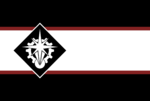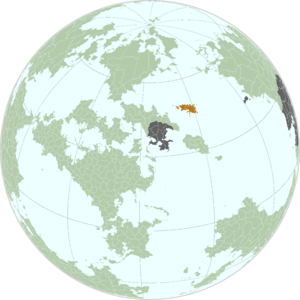Rissland
| The Commonhold of Rissland Die Gemeinschaft Rissland Héndhldeh Hromanom | |
| Flag | Coat of arms |
|---|---|

|

|
| Motto: | |
| Anthem: | |
| Locator map | |

| |
| Capital city | Fügung |
| Largest city | |
| Official language | Stoldish |
| Other languages | Eokoesr |
| Ethnic group | |
| Religion | Revisionist Dlroch'veldr, Stellist Orkanan, Irreligion |
| Demonym(s) | Risslandish, Risslander |
| Government | |
| Government Type | Orderist technocratic federal subject |
| Oberhauptführer | |
| Your 2nd leader title (e.g. Prime minister) | name |
| Legislature | Gründerrat |
| Establishment | |
| event 1 | date 1 |
| Area | |
| Population | |
| Economy | |
| Economy type | Orderist planned economy |
| Currency | Commonwealth Energy Certificate (GEA) () |
| Other information | |
| Driving side | right |
| Internet code | .soc |
Rissland, officially the Commonhold of Rissland (Stoldish: Gemeinschaft Rissland, Eokoesr: Héndhldeh Hromanom), is a country in Anaria.
History
- Main article: History of Rissland
- See also: Dhonowlgos
Foundation
The foundation of the Riss starts with the invasion of Dhonowlgos during the Helreich-Wolgos War in 7456-7460. The accounts of the entire invasion is unclear as reports of the ordeal miss entire sections and angles to the conflict. At the start of the invasion, it is known that overwhelming air and naval forces overcame Wolgos forces of the island's southern shores. Beach landings progressed and a bitter fight for the island proceeded for the following 14 months. At the 14 month mark, records of the conflict become significantly patchy and incomplete. During this time, Wolgos forces broke their lines and ordered a full retreat and evacuation of the island. It is known that the population of Dhonowlgos before the conflict was roughly 12 million, but reports by the Bind report only 4.5 million were evacuated, another 4 million Wolgos perished while 3.5 million Eokoesr were freed.
At the end of the conflict, Häverist forces stopped near the east coast and halted their advance as the Wolgos took a last stand. Ferocity of the defenders at this point of the war have been told in stories by survivors of the war. At this stage, the Hellish navy blockaded the eastern coasts of the island and started bombarding the coast, all while maintaining a siege of the surrounding lands. With food supplies being cut off or destroyed, the remaining Wolgos lasted 6 months before food supplies ran out, leaving the remaining Wolgos too weak to be effective in combat. No surrender was made by the Wolgos. All lands gained by the Häverists were now firmly under their control and was further on known by the name, the Riss, which in Stoldish means "the fissure".
Under the orders of the newly created Stolvic Häverist Commonwealth, the lands of the Riss were to become a Commonhold within the Commonwealth. Direktors were then and on forward chosen to rule the colonists that brave the choice of settling of the lands of the Riss.
Emancipation of the Eokoesr
The establishment of Rissland after the fall of Dhownolgos marked the beginning of a complex and challenging era, particularly in the integration and rehabilitation of the emancipated Eokoesr slaves. This period was characterized by immense hardship, cultural reconstruction, and the formation of a new societal identity.
Rissland inherited a land deeply scarred by war and the scorched-earth tactics of the retreating Wolgos. The destruction was all-encompassing: infrastructure was in ruins, agricultural lands were barren, forests were razed, and rivers were poisoned. Amidst this desolation, the Häverists faced the daunting task of rehabilitating the land and integrating over three and a half million emancipated Eokoesr slaves.
The Eokoesr, having endured centuries of oppression, emerged as a people devoid of direction and cultural identity. Their lives under Wolgos rule, marked by deprivation and inhumane treatment, left them without social cohesion, culture, or skills beyond basic labour. Many were physically mutilated or disabled, hindering their ability to communicate and function independently. The magnitude of their suffering and the loss of their cultural heritage were profound.
Initially, the Häverists were appalled by the Eokoesr's behaviour, which mirrored the savagery they had experienced under the Wolgos. However, understanding the deep psychological impact of their oppression, the liberators adopted a compassionate approach. They provided basic necessities like food, shelter, and clothing, and started to teach the Eokoesr the basics of self-sufficiency and community living.
A pivotal development in the rehabilitation process was the introduction of Hellish sign language. This initiative facilitated communication between the Eokoesr and their liberators, fostering understanding and cooperation. The Hellish personnel also played a crucial role in teaching the Eokoesr to form families and communities. These new social structures were formed pragmatically, as tracing lineage was impossible. The process of building families and communities from scratch was a testament to the depth of cultural erasure the Eokoesr had endured.
Over time, the Eokoesr, familiar with Wolgos culture, began to adopt aspects of it in their daily lives, such as clothing styles, language, and cuisine. This mimicry was initially problematic for the Häverists, who endeavored to integrate the Eokoesr into Helish culture. The result of these efforts was the emergence of a hybrid culture, blending Hellish and Wolgos influences. The Wolgos language, enriched with Hellish elements, became a symbol of this new cultural identity.
Wolgos question
The aftermath of the invasion of Dhownolgos presented significant challenges for the Häverist forces, particularly in dealing with the remaining Wolgos population. This period marked a complex and ultimately unsuccessful attempt at rehabilitation and integration, highlighting profound cultural and psychological differences.
In the wake of the invasion, hundreds of thousands of Wolgos were left behind as their brethren retreated. The Häverist forces, in an effort to control and manage this population, interned them in secluded valleys. However, they soon realized that the Wolgos were unlike any other population they had previously encountered or occupied. The Wolgos' resistance and cultural distinctiveness presented unique challenges for the Häverists.
Aiming to transform these Wolgos into Häverist citizens, the Häverist command, supported by academics, initiated rehabilitation programs. However, these efforts were met with stubborn resistance and outright rejection from the Wolgos community. The Wolgos' strong cultural identity and resistance to outside influence made the task of rehabilitation particularly arduous.
In a controversial move, the Häverist authorities decided to separate Wolgos children from their parents, intending to break the continuity of Wolgos culture. This decision was based on the belief that re-educating the younger generation would be more effective. However, the upbringing and re-education of Wolgos children proved to be a failure, largely due to a poor understanding of Wolgos psychology by the Häverist. The children often displayed behaviours such as deception, violence, and cruelty, which deeply troubled and demoralized their Hellish caregivers.
The re-education programs inadvertently raised a generation of maladapted Wolgos. Despite superficially adopting Hellish morals, many of these individuals were deeply troubled and posed a significant danger to society. The period was marked by numerous disturbances and crimes committed by these individuals, causing widespread concern and scandal.
After two decades of effort and significant resource expenditure, Helreich finally permitted its Wolgos population to leave for the Bind. By this time, however, the damage was substantial. Many Wolgos had died, and the attempts at integration were widely regarded as a failure.
Geography
Rissland is made up of a single large island accompanied by a collection of smaller islands of various sizes and significance, the islands have a wide variety of topography with plains, a volcanic plain and a two mountain ranges dominating the landscape, the islands are also well known for their considerable volcanic activity. The highest point in Rissland is Mount Whlor at 3728 meters above sea level, the total land area of 333,696 km2.
The islands are also characterized by their peculiar coasts where cliffs with narrow stony beaches are the dominant feature, the cliffs are occasionally interrupted by collapses that have formed access inland and where Wolgos villages and cities grew to take advantage of the access to the sea, where accesses were not available villages have built wooden ladders to artificial piers and many other villages use the cliff as a source of gull for wine production. In some rare occasions towns have been built into the cliff faces were openings and passages have been carved into the cliff face. The average height of most cliffs ranges between 5-10 meters with occasional variations of up to 50 meters. The straights between the islands tend to be deep with depth dropping significantly after a few meters from the coast but unlike the stormy sea the straights have milder currents and shallower waves.
Inland the plains of the islands benefit from the rich volcanic soils and abundant rains brought by the Stolvic ocean and are some of the most fertile soils in Anaria although their productivity is subject to Tyrian oscillations, vast expanses have been turned into farmland but a significant proportion of land remains forested as virgin forests or managed wood plantations. The forests have significant religious and cultural value in the Orkanan religion but are also important for sustain the island's population during the coldest epoch of the Tyrian oscillations where vast tracks of farmland become unsuitable for any activity other than pasturing sheep and reindeer.
The two mountain rangers are technically a single range that transverses the mainland but that is broken into by the rift valley, the rift valley is a long expanse with considerable geothermal and volcanic activity where the landscape is compromised of hilly volcanoes, barren ash expanses and open lava flows. Most volcanic activity is in the form of open lava flows and volcanic ash columns but rarely are pyroclastic explosions and flows seen which have allowed the area to be developed with minimal risk of significant destruction.
Governance
Economy
Infrastructure
Demographics
Society
Eokoesr Society and Culture
Rissland in the Stolvic Orderist Commonwealth (SOC) is known as the land of the Eokoesr, which makes up seventy-two per cent of the population. The Eokoers have greatly developed their culture in the past two centuries since the end of the Pan-Anarian War and emancipation. To the chagrin of the Hellish, Eokoesr culture remains entrenched in old Dhonowlgos traditions and has preserved the Wolgos language, a dialect they call Wokweokoesr, which has evolved away from standard Wolgos with many loanwords and loan grammar from Hellish.
The Eokoesr socially have evolved and risen from their once subservient attitude and are stereotypically renowned in the SOC for being stubborn, recalcitrant, easy to take offence and acting as if they had a chip on their shoulder. Attitudes that have borne out from the recovery of Wolgos dehumanisation and their resistance to SOC's past assimilation drive leading to the Eokoesr developing rebellious norms and an ease to take offence.
Culturally, the Eokoesr have taken ownership of old mores from the Wolgos dominion era and have retained deeply entrenched and superstitious attitudes. The hostile and fear-ridden world they once inhabited with curses, objects of power, spirits, and many monsters that were once employed to reinforce their subservience has been transformed into a mystical atmosphere that permeates the Dnkluwos islands. The Eokoesr have a deep and rich tradition of fiends, spirits, witchcraft, and magic that can be found in many aspects of their daily lives. They possess many taboos about daily activities, forbidden practices, and places. Their taboos about wandering into cursed places have led to the preservation of many pre-emancipation ruins, which they consider to be haunted and foreboding with ill fortune.
The Eokoesr have reinterpreted and taken ownership of the Dlroch'veldr faith, shedding its anti-human practices and dogma while firmly establishing through academic debate and research that the faith had been corrupted. They have endeavoured to bring it back to long-lost roots that are supposed to nurture the Eokoesr and other humans—a reinterpretation that puts the SOC Eokoesr at odds with the Wolgos. The Eokoesr has shed all blood sacrifices and extreme ascetic practices from the faith and has synthesised new forms of worship and clergy. Nevertheless, the Eokoesr Leykold retains practically all superstitions and allusions to the magic that the standard Wolgos Leykold possesses.
Eokoesr cuisine has diverged greatly from the Wolgos cuisine they once encountered. Traditionally, Wolgos cuisine is not healthy for humans due to its extremely high protein makeup. Still, nonetheless, Eokoesr cuisine incorporated wolgos dishes with those of rural Eokoesr who could develop their own cuisine. Unlike the Wolgos, the Eokoesr enjoy a plethora of fresh bread, hearty sweet or savoury grain stews alongside cured meats, root vegetables and many kinds of dairy products and animal fats.